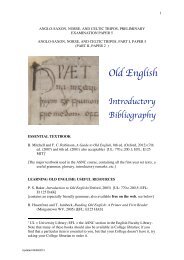Scandinavian history in the Viking age - Department of Anglo-Saxon ...
Scandinavian history in the Viking age - Department of Anglo-Saxon ...
Scandinavian history in the Viking age - Department of Anglo-Saxon ...
You also want an ePaper? Increase the reach of your titles
YUMPU automatically turns print PDFs into web optimized ePapers that Google loves.
<strong>Scand<strong>in</strong>avian</strong> History <strong>in</strong> <strong>the</strong> Vik<strong>in</strong>g Age<br />
[B603] Háttatal conta<strong>in</strong>s a large number <strong>of</strong> sample verses to illum<strong>in</strong>ate <strong>the</strong> pr<strong>in</strong>ciples set out by Snorri<br />
elsewhere. Text: A. Faulkes, Snorri Sturluson, Edda: Háttatal (1991) [UL 752:26.c.95.20], see also<br />
(B498)<br />
Individual poems<br />
Def<strong>in</strong><strong>in</strong>g a corpus <strong>of</strong> ‘Eddaic’ verse is difficult enough, but <strong>the</strong> problem is compounded by <strong>the</strong><br />
bewilder<strong>in</strong>g variety shown by its various constituents. The various <strong>in</strong>dividual poems seem likely to come<br />
from a wide range <strong>of</strong> places, dates, and contexts, and to have filled a wide range <strong>of</strong> functions.<br />
Accord<strong>in</strong>gly, <strong>the</strong> follow<strong>in</strong>g def<strong>in</strong>ition <strong>of</strong> sub-groups is necessarily vague; only a selection <strong>of</strong> collected<br />
texts and translations are referred to, but <strong>the</strong> reader is rem<strong>in</strong>ded <strong>of</strong> <strong>the</strong> o<strong>the</strong>r items <strong>in</strong> <strong>the</strong> sections above<br />
(B585 ff.).<br />
Eschatological poems<br />
Many Norse poems touch on eschatological <strong>the</strong>mes, but only one does it properly.<br />
[B605] V²luspá is <strong>the</strong> <strong>in</strong>dubitable epic <strong>of</strong> Eddaic verse, tell<strong>in</strong>g <strong>of</strong> <strong>the</strong> rais<strong>in</strong>g <strong>of</strong> a sibyl to answer<br />
questions about <strong>the</strong> fate <strong>of</strong> gods and <strong>the</strong> world. Its picture <strong>of</strong> eschatology (K50 ff.) is <strong>the</strong> most coherent to<br />
come through from <strong>the</strong> poetic sources, and has <strong>of</strong>ten been considered a pagan reaction to Christianity,<br />
whose <strong>in</strong>fluence can probably be identified at numerous po<strong>in</strong>ts. Text: (B587), I:1-16; S. Nordal, V²luspá<br />
, transl. B. Benedikz and J. McK<strong>in</strong>nell, Durham and St. Andrews medieval texts 1, corr. repr. (1984) [UL<br />
L700.c.209.1a]. Text and transl.: (B591):1-153 with extensive commentary. Transl. (B594):1-13;<br />
(B595):1-10; (B1):204-12; (B596):3-13. See also: S. Nordal, ‘Three essays on Völuspá’, SBVS 18 (1970-<br />
73), 79-135; S. Nordal, ‘The author <strong>of</strong> Völuspá’, SBVS 20 (1978-81), 114-30; R. Boyer, ‘On <strong>the</strong><br />
composition <strong>of</strong> Völuspá’, (B575):117-33; <strong>the</strong> contributions <strong>in</strong> (A61g), <strong>in</strong>cl. J.E. Qu<strong>in</strong>n, ‘Völuspá and <strong>the</strong><br />
composition <strong>of</strong> Eddic verse’, 303-20; (K13):107-28<br />
Wisdom poems<br />
A particularly characteristic group are poems which seem encapsulate <strong>the</strong> ritual shar<strong>in</strong>g <strong>of</strong> sacred lore <strong>in</strong><br />
poetic form; <strong>the</strong>se <strong>of</strong>ten take <strong>the</strong> form <strong>of</strong> contents between <strong>the</strong> protagonists (usually <strong>in</strong>volv<strong>in</strong>g Od<strong>in</strong> some<br />
disguise or o<strong>the</strong>r), and can be compared with <strong>the</strong> ‘flyt<strong>in</strong>g’ (B611 ff.) poems.<br />
[B606] Alvíssmál is now widely thought to date from <strong>the</strong> mediaeval period, and chronicles a contest <strong>of</strong><br />
vocabulary between Thor and <strong>the</strong> dwarf Alvís. Text: (B587), I:124-29. Transl.: (B594):110-16;<br />
(B595):90-96; (B596):109-13<br />
[B607] Baldrs draumar can perhaps be considered <strong>the</strong> sequel to Völuspá (B605); it is not preserved <strong>in</strong><br />
<strong>the</strong> Codex Regius, and seems perhaps to be an early mediaeval account <strong>of</strong> Od<strong>in</strong> question<strong>in</strong>g <strong>of</strong> a sibyl<br />
about <strong>the</strong> fate <strong>of</strong> his son Baldr. Text: (B587), I:277-79. Transl.: (B594):117-19; (B596):243-45. See also<br />
<strong>the</strong> items cited under Völuspá and R.L. Dieterle, ‘The song <strong>of</strong> Baldr’, SS 58 (1986), 285-307<br />
[B608] Grímnismál, leav<strong>in</strong>g aside <strong>the</strong> prose surround<strong>in</strong>gs, consists <strong>of</strong> a recitation <strong>of</strong> wisdom by Od<strong>in</strong>, <strong>of</strong><br />
particular <strong>in</strong>terest for its details <strong>of</strong> Valhalla (K55 ff.). Text: (B587), I:57-68. Transl.: (B594):53-64;<br />
(B595):46-49; (B596):50-60. See also: B. Ralph, ‘The composition <strong>of</strong> Grímnismál’, ANF 87 (1972), 97-<br />
118<br />
[B609] Hávamál seems to be a composite text <strong>of</strong> various parts, such as home-spun or proverbial<br />
wisdom, reflections upon social <strong>in</strong>teraction, and mythological material, particularly <strong>in</strong> <strong>the</strong> form <strong>of</strong> Od<strong>in</strong>’s<br />
life story. Text: (B587), I:17-44; D.A.H. Evans, Hávamál, VSNR TS 7 (1986) [UL 752:1.d.2.7]. Text<br />
and transl.: D.E. Mart<strong>in</strong> Clarke, The Hávamál, with selections from o<strong>the</strong>r poems <strong>of</strong> <strong>the</strong> Edda, illustrat<strong>in</strong>g<br />
<strong>the</strong> wisdom <strong>of</strong> <strong>the</strong> north <strong>in</strong> hea<strong>the</strong>n times (1923) [UL 752:26.c.90.7]. Transl.: (B594):14-41; (B595):11-<br />
35; (B596): 14-38; fur<strong>the</strong>r excerpts transl. (B1):139-44, 212-15. Cf. C. Larr<strong>in</strong>gton, ‘Hávamál and sources<br />
outside Scand<strong>in</strong>avia’, SBVS 23 (1990-93), 141-57<br />
[B610] Vafþrúðnismál sees Od<strong>in</strong> aga<strong>in</strong> <strong>in</strong>dulg<strong>in</strong>g <strong>in</strong> a wisdom contest, this time with <strong>the</strong> rash giant<br />
Vafthrudnir. Text: (B587), I:45-55; T.W. Machan, Vafþrúðnismál, Durham medieval texts 6 (1988)<br />
[ASNC]. Transl.: (B594):42-52; (B595):36-45; (B1):183-91; (B596):39-49. See also (K13):87-106<br />
43






